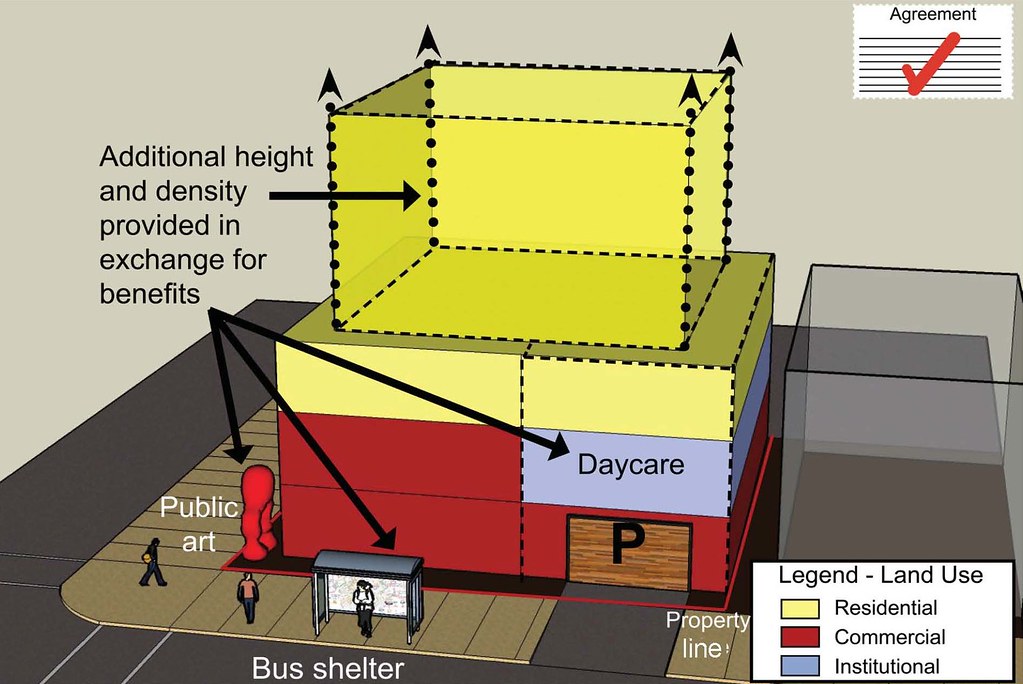
As condo after condo is planned in the Wellington West neighbourhood, intensification is seen as an inevitable by many local citizens. City of Ottawa planners and councilors promote intensification all the while musing on the increased tax base a new seven storey condo will provide. Citizens begrudgingly accept that the new condo development, whether in their backyard, on their street, or in their neighbourhood will increase traffic but they also hope that the new developments may encourage new businesses and increase public transit and community services. But what really is driving this move to intensify our cities?
The promotion of urban intensification, or densification or infill as it is otherwise known, can be attributed in part to the popularization of the urban planning theory of Smart Growth. Smart Growth theory promotes the construction and reconstruction of compact communities in the center of the city, as a more sustainable approach than continuing urban sprawl. Smart growth communities are transit oriented, bicycle and pedestrian friendly and promote local jobs and services.
Smart growth policies and practices, struggle with how to densify an urban neighbourhood and still make room for diversity and equity. Although equity is part of Smart Growth in theory, it is often a challenge in many communities in practice. In thinking about the multitude of new construction taking place on Wellington and Richmond roads there is an absence of even a glimmer of affordable housing and instead the heightened popularity of the area is increasing the costs of housing and rental units and pricing many long time residents right out of the market and the area.
One land use planning tool prescribed by the Ontario Ministry of Municipal Affairs and Housing to compensate a community for allowing increased height and density in their neighbourhood is Height and Density Bonusing. In exchange for increased height that surpasses the zoning by-law, developers are required to provide a service or benefit to the community as negotiated by the municipality. For example, an additional two storeys would require the developer to set aside a space inside the building for affordable housing, daycare facility or restore a local park. Some European countries have incentives to trade density for green roofs and other environmental services. Toronto and Vancouver have long established histories of using density bonusing to encourage the developer to give back to the community. The City of Ottawa does not yet. Density bonusing policies must be written into a municipality’s Official Plan in order for it to be used as a development tool.
Since the early 1990’s the City of Ottawa has made intensification part of its planning strategy. In the proposed Official Plan, the City has established density targets that it hopes to reach through intensification. In the Wellington West neighbourhood, intensification is hurling along but there seems to be an absence of other aspects of Smart Growth. Where is the increased access to transit, bike lanes and affordable housing? How is the intensification of our neigbourhood actually limiting sprawl into the greenbelt and beyond? Why are City staff not encouraging the use of tools like density bonusing to give back to the community?

4 comments
Public art is definitely something that can make urban neighbourhoods more livable. The City of Ottawa has a policy on public art that only the city itself seems to follow, with very few exceptions. Minto is one recent exception with the Noel Harding piece on their Kent/Slater plaza.
Enacting a public art program like Toronto’s Percent for Public Art, requiring developers to commit a percentage of their gross budget to public could be another chip for the city to hold in the height/density game.
One problem along Wellington Street is that the recent sewer/water pipe replacement program with the new streetscaping it has created, made improved transit stop facilities and bike lanes more difficult to implement. The bulb-outs make bike lanes diificult if not impossible and the reduced road space has made transit slower during the rush hour periods. Density bounses also can backfire if your city is not use to negotiating with them. It took many bad deals with developers early on, before the city of Toronto got to the point that it became competant in securing real benefits from developers. Some argue that they still have not got it right.
That is interestng – I did not realise that the City did not have density bonusing. Moving here from Vancouver, I thought it was a normal tool used to force developers to pay for civic amenities.
Allegra, are you saying Ottawa doesn’t have density incentives written into its OP? Wouldn’t Section 5.2.1.8 qualify?
found at: http://ottawa.ca/city_hall/ottawa2020/official_plan/vol_1/05_implementation/index_en-02.html
“Increase in Height and Density By-law
8. Pursuant to Section 37 of the Planning Act, the City may authorize increases in the height and density of development above the levels otherwise permitted by the zoning by-law. Public consultation will be included in the development and approval of such a by-law. Limited increases will be permitted in return for the provision of such facilities, services or matters as are set out in the by-law. Such provisions that may be authorized include, but are not limited to:
1. Public cultural facilities;
2. Building design and public art;
3. Conservation of heritage resources;
4. Conservation/replacement of rental housing;
5. Provision of new affordable housing units; land for affordable housing, or, at the discretion of the owner, cash-in-lieu of affordable housing units or land; [Amendment 10, August 25, 2004]
6. Child care facilities;
7. Improvements to rapid-transit stations;
8. Other local improvements identified in community design plans, community improvement plans, capital budgets, or other implementation plans or studies;
9. Artist live-work studios.”